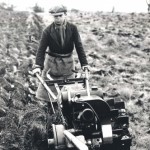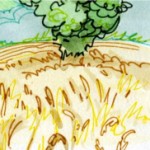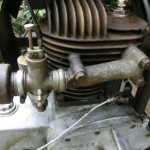Home › Forums › General › Help and information › Mystery Object- Let's See how Much You Know
- This topic has 25 replies, 10 voices, and was last updated 10 years, 4 months ago by
 trusty220.
trusty220.
-
AuthorPosts
-
August 11, 2015 at 7:47 pm #14014
 trusty220Keymaster
trusty220KeymasterGetting colder again!
August 11, 2015 at 9:26 pm #14015 hillsiderParticipant
hillsiderParticipantHow about sampling straw, checking for over heating in the centre of the Stack.
August 11, 2015 at 11:20 pm #14017moggyjim
Participantgiant cheese wheel tester or to stop hay ricks heating when made to green..
August 12, 2015 at 8:32 am #14018 vhgmcbuddyMember
vhgmcbuddyMemberCould it be a drain cleaner. On a lighter note how about a long range bulb planter.
August 13, 2015 at 7:10 am #14041 trusty220Keymaster
trusty220KeymasterAgain, some guesses were getting warm, some wide of the mark. Answer on Saturday night if nobody comes up with it before.
Keep coming up with the ideas!August 16, 2015 at 2:13 pm #14071 vhgmcbuddyMember
vhgmcbuddyMemberI looked back to see the answer, so one more try. sluice lock key.
August 16, 2015 at 5:09 pm #14073 trusty220Keymaster
trusty220KeymasterA little bit overdue but worth the wait.
The object is a boring tool for preventing spontaneous combustion in haystacks- that’s why I said that one or two of you were getting warm.
If the haystack was seen to be heating up (steam coming out of the top, or even smoke) then this borer was taken to the top of the stack and wound down to form a chimney and relieve the heat build-up within the stack. The bottom of the cylindrical piece is sharpened and it’s weight would take it into the stack if the handles were rotated. It would have to be lifted out every couple of feet to empty the cutter, then re-entered into the hole until the whole of the cutter had been inserted. Because it is so heavy you couldn’t use it in a horizontal way, it would have to be vertical.
Of course haystacks don’t normally heat up or catch fire if the hay has been made properly, but if the weather has been wet the farmer wouldn’t have much choice and would have had to make the hay with a higher than normal moisture content. It is then that the problems start with microbes within the stack starting a fermentation process which generates heat to such an extent that some stacks have been known to catch fire.
I hope that sheds a little light on this very interesting device; it certainly gives us an insight into old methods of haymaking.
Thank you all for participating in this little quiz. Maybe someone else would like to test our knowledge with another mystery item? The field is wide open……
August 16, 2015 at 6:20 pm #14075 vhgmcbuddyMember
vhgmcbuddyMemberWell done Geoff, interesting. Have to count this as one to you.
August 16, 2015 at 10:33 pm #14081 wristpinParticipant
wristpinParticipantOf course haystacks don’t normally heat up or catch fire if the hay has been made properly, but if the weather has been wet the farmer wouldn’t have much choice and would have had to make the hay with a higher than normal moisture content. It is then that the problems start with microbes within the stack starting a fermentation process which generates heat to such an extent that some stacks have been known to catch fire.
Way back when conditions dictated stacking a less than ideal crop the risk of heating was reduced by building the stack with alternate layers of hay and straw. The straw provided ventilation and a “wicking effect” to draw out the moisture.
August 17, 2015 at 1:43 pm #14085 hillsiderParticipant
hillsiderParticipantAs you say, warm but not warm enough.
When we emptied my late fathers shed we unearthed what I beleive to be sampling rod for hay stacks etc it was about 8 feet long with a rope eye at the handle end and a pointed end with a barb like a fish hook at the business end. I no longer have it is in a local collection now so I can’t send a photo.
Re overheating hay stacks one did just that on the farm where I lived as youngster as well as seeing it steaming etc you could smell it warming up before it ignited. I don’t know how it would be dealt with now but back then it was dealt with by one fire crew and the farm hands by dismanting the stack and spreading it over the meadow next to the stack yard where some smouldered away and the rest cooled down, but the smell lingered on for days after the event.
The highlight of the say for us kids was to have our photo taken standing in front of the fire engine.August 17, 2015 at 2:15 pm #14086 trusty220Keymaster
trusty220KeymasterThat’s the way a lot of farmers used to test for overheating- they used to push a long, pointed steel rod into the centre and it would conduct the heat to the outside.
It’s amazing what memories our club members have when they start to get stirred up! Well done, again, to everyone who had a guess.
Has anyone out there got anything as interesting that they could test our knowledge with?
-
AuthorPosts
- You must be logged in to reply to this topic.
